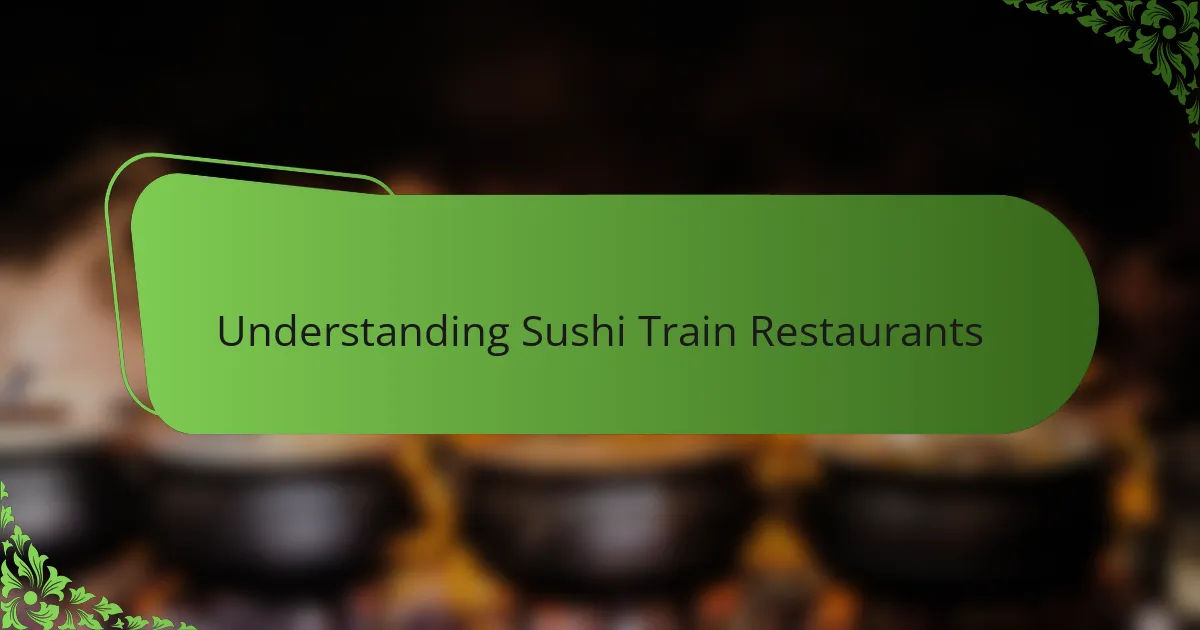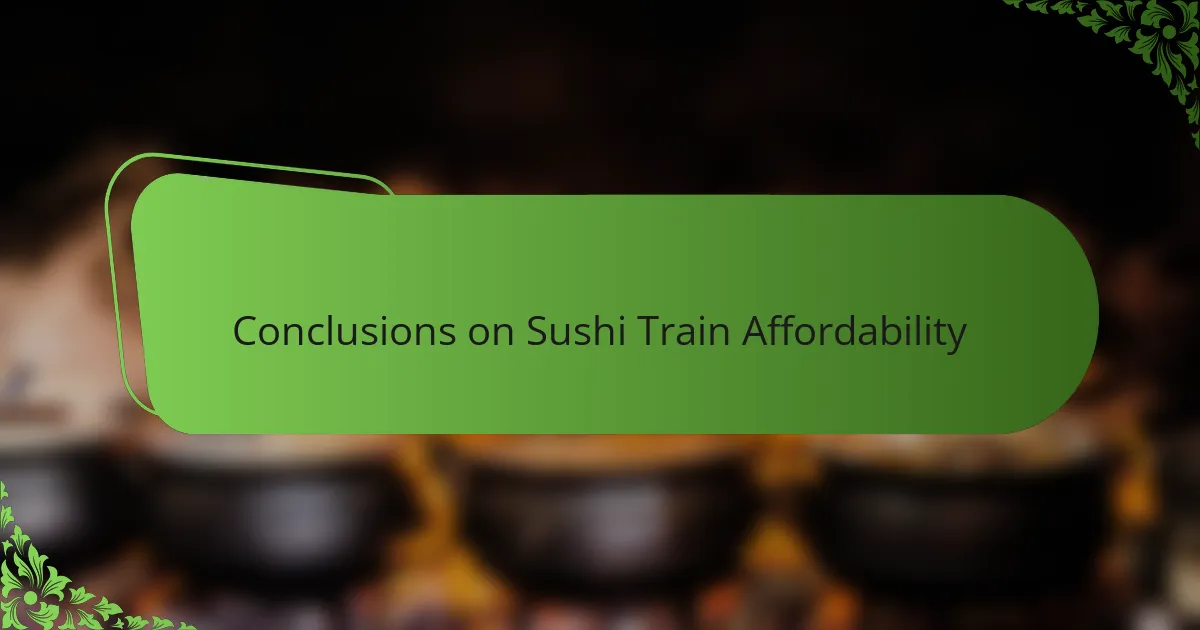Key takeaways
- Sushi Train’s conveyor belt system creates a fun and interactive dining experience, allowing customers to choose plates at their own pace.
- Affordability involves not only prices but also portion sizes and quality; how many plates one eats plays a significant role in perceived value.
- Diners should be mindful of their spending and portion sizes to find balance between enjoyment and avoiding overspending.
- Overall satisfaction at Sushi Train is influenced by personal appetite and the temptation of colorful plates, requiring awareness during the meal.

Understanding Sushi Train Restaurants
Sushi Train restaurants have always intrigued me with their unique conveyor belt system. Watching plates of sushi glide past you creates a fun and interactive dining experience that feels both casual and exciting. Have you ever found yourself reaching for that colorful plate just because it caught your eye as it whizzed by?
From my visits, I noticed that Sushi Train offers a wide variety of sushi types, making it easy for anyone to find something they enjoy. It’s impressive how this setup allows you to customize your meal at your own pace, without the pressure of ordering all at once. This style feels welcoming, especially for people who might be new to sushi.
One question I often ask myself when I’m there is whether the convenience and entertainment factor translate into reasonable prices. Having seen the mix of plates glide by, I started paying attention to price points and portion sizes—a small detail that can make all the difference when deciding if it’s worth a repeat visit.

Factors Defining Affordability in Sushi Dining
Affordability in sushi dining at places like Sushi Train isn’t just about the sticker price on the menu. I’ve realized that it’s also about how many plates you end up eating to feel satisfied. For instance, those tempting mini rolls may seem cheap individually, but I found myself grabbing several, which quickly added up. Have you ever felt that lure too—small bites that become a full meal without you noticing?
Another thing I think about is the balance between quality and cost. Sometimes spending a bit more on fresher fish or a specialty roll can feel worth it, especially when you compare it to cheaper alternatives that don’t quite hit the mark. From my experience, Sushi Train walks this line differently at each location, which makes pricing feel subjective rather than fixed.
Finally, timing and portion size play a big role in how affordable your sushi train experience feels. I noticed that going during peak hours sometimes means faster plate turnover, so you can try more options without lingering too long. On the flip side, slower times might make you order more to enjoy the atmosphere, nudging the bill higher. Have you found yourself eating differently based on when you visit?

Setting Criteria for Affordability Survey
When I set out to survey Sushi Train’s affordability, I knew I needed clear criteria to make sense of my experience. It wasn’t enough to just look at prices—I had to consider portion sizes, how filling the plates were, and whether the quality justified the cost. After all, does paying less truly mean better value if you leave still hungry?
I also decided to track how many plates it took for me to feel satisfied, because that number told a different story than just scanning the menu. Sometimes, a handful of small plates might add up to more than a single large dish elsewhere. I wondered, how many people actually think about this when they’re happily grabbing one plate after another?
Beyond numbers, I reflected on the overall feeling of the meal. Affordability isn’t just a math equation for me—it’s about whether the experience feels worth it, both in taste and enjoyment. Did I feel content without stretching my budget painfully? Setting this kind of criterion helped me separate a mere bargain from genuine value.

Methodology for Sushi Train Price Survey
To gather meaningful data for my Sushi Train price survey, I made a point of visiting multiple locations to capture a range of pricing and portion sizes. I jotted down the price of each plate color and noted how much sushi came on each one, because numbers alone don’t tell the whole story. Have you ever thought about how a $5 plate might feel different depending on whether it’s packed with sushi or just a couple of small pieces?
While dining, I also kept track of how many plates I needed before feeling truly satisfied. This wasn’t just about filling my stomach—it was about understanding the real cost of a typical meal there. Sometimes I was surprised to find that the delight of those quick bites led me to order more than I planned, making affordability a moving target.
Lastly, I reflected on the overall dining atmosphere and how it influenced my spending. Did the fun conveyor belt make me reach for extra plates just because they caught my eye? Or did the environment encourage me to stick to a budget? Including these personal observations helped me create a fuller picture of affordability beyond just price tags.

Recording and Analyzing Price Data
Recording price data at Sushi Train felt like piecing together a subtle puzzle. I made sure to write down prices for each plate color as soon as they arrived, because I quickly noticed that the color coding wasn’t just for looks—it directly linked to cost. Have you ever tried to guess a dish’s price before seeing a menu? This method helped me keep track without breaking the flow of my meal.
Then came the analysis, which was more than just adding numbers; it was about comparing what you get for the price. For example, some plates looked tiny but carried a premium price, while others surprised me with a generous portion at a lower cost. I found myself asking: Am I paying for quality, quantity, or just the visual appeal on the belt?
I also found value in looking at the bigger picture, like figuring out how much I’d spend on a satisfying meal rather than just a single plate. Keeping a tally of plates consumed gave me real insight into affordability—not just theory. It made me think hard about whether grabbing that tempting extra plate was worth stretching the budget, or if I should hold back and savor what I had.

Personal Experience at Sushi Train
During my visits to Sushi Train, I was struck by how easy it was to lose track of how many plates I’d taken. Each colorful dish looked tempting, and I often found myself wondering if I was eating out of hunger or just curiosity. Have you ever started with just one or two plates and ended up finishing a surprising number without realizing it?
I remember one meal when I tried to gauge affordability by setting a mental cap on my spending. It was challenging because the conveyor belt kept bringing new options right within reach—making restraint difficult. Despite that, I felt a genuine satisfaction not only from the food but from managing to enjoy the experience without overspending.
What surprised me most was how portion size affected my feeling of fullness. Some smaller plates took me several helpings to feel content, while a slightly pricier plate with more generous portions made me feel satisfied faster. This made me think: Is Sushi Train’s affordability truly about price, or about understanding what combination of plates gives you the best value for your appetite?

Conclusions on Sushi Train Affordability
Reflecting on my survey, I realized that Sushi Train’s affordability isn’t a straightforward measure. It’s more about finding that sweet spot between price, portion size, and personal appetite. Have you ever left feeling unsure whether you scored a bargain or just paid for the novelty of the conveyor? That’s exactly the balancing act I grappled with.
In my experience, some plates felt like a steal, offering decent portions at reasonable prices, while others seemed to nudge me to order just one more—making the meal more expensive than it first appeared. It made me think about how much our decisions at the belt are influenced by this subtle play between value and temptation.
Ultimately, affordability at Sushi Train depends on how mindful you are while dining. If you can tune into portion sizes and recognize when satisfaction has been met, you can enjoy a fun meal without a surprise bill. Do you think you could keep that balance, or would you fall for the colorful plates like I sometimes did?



